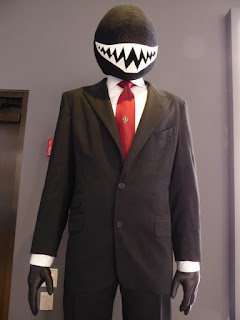Following on from my last build I decided to keep practicing more with using EVA foam as a prop making material, I was commissioned to make a replica of Aku Aku, a character from the game franchise Crash Bandicoot.
After drawing up templates the shapes were transferred to EVA Foam and cut out, the pieces were then rounded and smoothed using a dremel with a sanding drum attachment and then finished off with 400 grit sandpaper.
The next step was adding the wood grain texture to the pieces, I drew out a basic texture using a black rollerball pen so that I didn't indent the foam and could draw with a nice thin line unlike a sharpie. The lines were lightly scored using a scalpel and then hit with a heat gun to open them up. For they eyes I made clear plastic copies using worbla's transpa art.
At this point the foam was sealed with 4 thin coats of white plastidip, using white left me with a good base for the colours and once the white was dry I masked off the facial features so they could be painted.
I used a few different paints for the colours on the mask, I used red plastidip for the brows, nose and lips. The eye bags were painted by hand using acrylic and the wood was painted using spraypaint. I wanted to use a variety to see how they worked with foam (this was tested on scraps first!) The spray paint was flexible but not to the same degree as the acrylic, it worked fine for this project but if I were to paint something that would be being flexed repeatedly I would opt to use a latex paint.
The eyes were painted on the inside using acrylics, I gradiated from red to yellow to give a warm glow, this was done by stippling the colours inside to give a rougher finish as airbrushing the colours I felt would have looked too clean and perfect for the characters appearance.
The final step was detailing, using acrylic washes I built up grime to seep into the grain of the pieces and dull the bright colours down a little to make him a little more realistic. Light dry brushing was applied in certain areas to bring the colour back through, at this point the eye lenses were attached along with the feathers and his goatee which was made from an artificial leaf.
After drawing up templates the shapes were transferred to EVA Foam and cut out, the pieces were then rounded and smoothed using a dremel with a sanding drum attachment and then finished off with 400 grit sandpaper.
The next step was adding the wood grain texture to the pieces, I drew out a basic texture using a black rollerball pen so that I didn't indent the foam and could draw with a nice thin line unlike a sharpie. The lines were lightly scored using a scalpel and then hit with a heat gun to open them up. For they eyes I made clear plastic copies using worbla's transpa art.
At this point the foam was sealed with 4 thin coats of white plastidip, using white left me with a good base for the colours and once the white was dry I masked off the facial features so they could be painted.
I used a few different paints for the colours on the mask, I used red plastidip for the brows, nose and lips. The eye bags were painted by hand using acrylic and the wood was painted using spraypaint. I wanted to use a variety to see how they worked with foam (this was tested on scraps first!) The spray paint was flexible but not to the same degree as the acrylic, it worked fine for this project but if I were to paint something that would be being flexed repeatedly I would opt to use a latex paint.
The eyes were painted on the inside using acrylics, I gradiated from red to yellow to give a warm glow, this was done by stippling the colours inside to give a rougher finish as airbrushing the colours I felt would have looked too clean and perfect for the characters appearance.
The final step was detailing, using acrylic washes I built up grime to seep into the grain of the pieces and dull the bright colours down a little to make him a little more realistic. Light dry brushing was applied in certain areas to bring the colour back through, at this point the eye lenses were attached along with the feathers and his goatee which was made from an artificial leaf.




























































